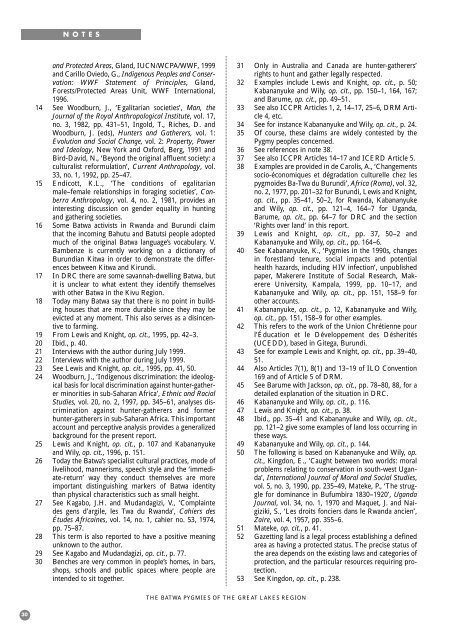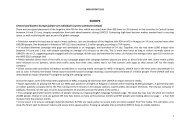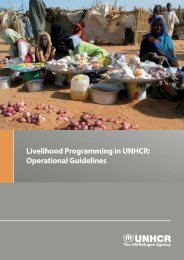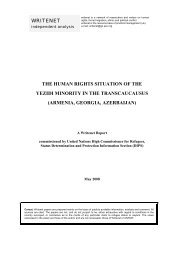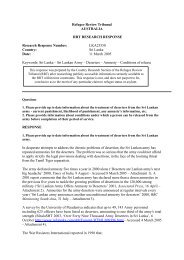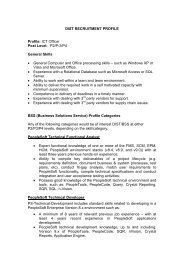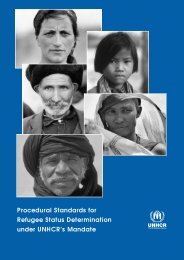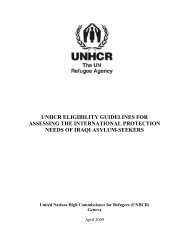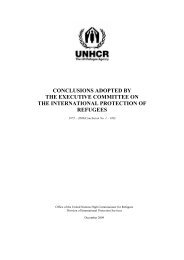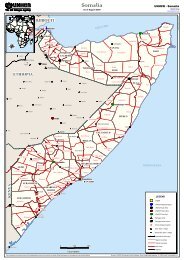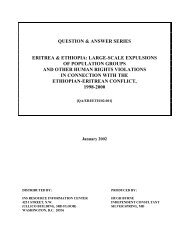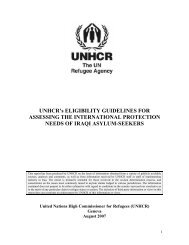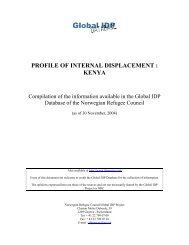The Batwa Pygmies of the Great Lakes Region - UNHCR
The Batwa Pygmies of the Great Lakes Region - UNHCR
The Batwa Pygmies of the Great Lakes Region - UNHCR
You also want an ePaper? Increase the reach of your titles
YUMPU automatically turns print PDFs into web optimized ePapers that Google loves.
30<br />
NOTES<br />
and Protected Areas, Gland, IUCN/WCPA/WWF, 1999<br />
and Carillo Oviedo, G., Indigenous Peoples and Conservation:<br />
WWF Statement <strong>of</strong> Principles, Gland,<br />
Forests/Protected Areas Unit, WWF International,<br />
1996.<br />
14 See Woodburn, J., ‘Egalitarian societies’, Man, <strong>the</strong><br />
Journal <strong>of</strong> <strong>the</strong> Royal Anthropological Institute, vol. 17,<br />
no. 3, 1982, pp. 431–51, Ingold, T., Riches, D. and<br />
Woodburn, J. (eds), Hunters and Ga<strong>the</strong>rers, vol. 1:<br />
Evolution and Social Change, vol. 2: Property, Power<br />
and Ideology, New York and Oxford, Berg, 1991 and<br />
Bird-David, N., ‘Beyond <strong>the</strong> original affluent society: a<br />
culturalist reformulation’, Current Anthropology, vol.<br />
33, no. 1, 1992, pp. 25–47.<br />
15 Endicott, K.L., ‘<strong>The</strong> conditions <strong>of</strong> egalitarian<br />
male–female relationships in foraging societies’, Canberra<br />
Anthropology, vol. 4, no. 2, 1981, provides an<br />
interesting discussion on gender equality in hunting<br />
and ga<strong>the</strong>ring societies.<br />
16 Some <strong>Batwa</strong> activists in Rwanda and Burundi claim<br />
that <strong>the</strong> incoming Bahutu and Batutsi people adopted<br />
much <strong>of</strong> <strong>the</strong> original <strong>Batwa</strong> language’s vocabulary. V.<br />
Bambenze is currently working on a dictionary <strong>of</strong><br />
Burundian Kitwa in order to demonstrate <strong>the</strong> differences<br />
between Kitwa and Kirundi.<br />
17 In DRC <strong>the</strong>re are some savannah-dwelling <strong>Batwa</strong>, but<br />
it is unclear to what extent <strong>the</strong>y identify <strong>the</strong>mselves<br />
with o<strong>the</strong>r <strong>Batwa</strong> in <strong>the</strong> Kivu <strong>Region</strong>.<br />
18 Today many <strong>Batwa</strong> say that <strong>the</strong>re is no point in building<br />
houses that are more durable since <strong>the</strong>y may be<br />
evicted at any moment. This also serves as a disincentive<br />
to farming.<br />
19 From Lewis and Knight, op. cit., 1995, pp. 42–3.<br />
20 Ibid., p. 40.<br />
21 Interviews with <strong>the</strong> author during July 1999.<br />
22 Interviews with <strong>the</strong> author during July 1999.<br />
23 See Lewis and Knight, op. cit., 1995, pp. 41, 50.<br />
24 Woodburn, J., ‘Indigenous discrimination: <strong>the</strong> ideological<br />
basis for local discrimination against hunter-ga<strong>the</strong>rer<br />
minorities in sub-Saharan Africa’, Ethnic and Racial<br />
Studies, vol. 20, no. 2, 1997, pp. 345–61, analyses discrimination<br />
against hunter-ga<strong>the</strong>rers and former<br />
hunter-ga<strong>the</strong>rers in sub-Saharan Africa. This important<br />
account and perceptive analysis provides a generalized<br />
background for <strong>the</strong> present report.<br />
25 Lewis and Knight, op. cit., p. 107 and Kabananyuke<br />
and Wily, op. cit., 1996, p. 151.<br />
26 Today <strong>the</strong> <strong>Batwa</strong>’s specialist cultural practices, mode <strong>of</strong><br />
livelihood, mannerisms, speech style and <strong>the</strong> ‘immediate-return’<br />
way <strong>the</strong>y conduct <strong>the</strong>mselves are more<br />
important distinguishing markers <strong>of</strong> <strong>Batwa</strong> identity<br />
than physical characteristics such as small height.<br />
27 See Kagabo, J.H. and Mudandagizi, V., ‘Complainte<br />
des gens d’argile, les Twa du Rwanda’, Cahiers des<br />
Études Africaines, vol. 14, no. 1, cahier no. 53, 1974,<br />
pp. 75–87.<br />
28 This term is also reported to have a positive meaning<br />
unknown to <strong>the</strong> author.<br />
29 See Kagabo and Mudandagizi, op. cit., p. 77.<br />
30 Benches are very common in people’s homes, in bars,<br />
shops, schools and public spaces where people are<br />
intended to sit toge<strong>the</strong>r.<br />
THE BATWA PYGMIES OF THE GREAT LAKES REGION<br />
31 Only in Australia and Canada are hunter-ga<strong>the</strong>rers’<br />
rights to hunt and ga<strong>the</strong>r legally respected.<br />
32 Examples include Lewis and Knight, op. cit., p. 50;<br />
Kabananyuke and Wily, op. cit., pp. 150–1, 164, 167;<br />
and Barume, op. cit., pp. 49–51.<br />
33 See also ICCPR Articles 1, 2, 14–17, 25–6, DRM Article<br />
4, etc.<br />
34 See for instance Kabananyuke and Wily, op. cit., p. 24.<br />
35 Of course, <strong>the</strong>se claims are widely contested by <strong>the</strong><br />
Pygmy peoples concerned.<br />
36 See references in note 38.<br />
37 See also ICCPR Articles 14–17 and ICERD Article 5.<br />
38 Examples are provided in de Carolis, A., ‘Changements<br />
socio-économiques et dégradation culturelle chez les<br />
pygmoides Ba-Twa du Burundi’, Africa (Roma), vol. 32,<br />
no. 2, 1977, pp. 201–32 for Burundi, Lewis and Knight,<br />
op. cit., pp. 35–41, 50–2, for Rwanda, Kabananyuke<br />
and Wily, op. cit., pp. 121–4, 164–7 for Uganda,<br />
Barume, op. cit., pp. 64–7 for DRC and <strong>the</strong> section<br />
‘Rights over land’ in this report.<br />
39 Lewis and Knight, op. cit., pp. 37, 50–2 and<br />
Kabananyuke and Wily, op. cit., pp. 164–6.<br />
40 See Kabananyuke, K., ‘<strong>Pygmies</strong> in <strong>the</strong> 1990s, changes<br />
in forestland tenure, social impacts and potential<br />
health hazards, including HIV infection’, unpublished<br />
paper, Makerere Institute <strong>of</strong> Social Research, Makerere<br />
University, Kampala, 1999, pp. 10–17, and<br />
Kabananyuke and Wily, op. cit., pp. 151, 158–9 for<br />
o<strong>the</strong>r accounts.<br />
41 Kabananyuke, op. cit., p. 12, Kabananyuke and Wily,<br />
op. cit., pp. 151, 158–9 for o<strong>the</strong>r examples.<br />
42 This refers to <strong>the</strong> work <strong>of</strong> <strong>the</strong> Union Chrétienne pour<br />
l’Éducation et le Développement des Désherités<br />
(UCEDD), based in Gitega, Burundi.<br />
43 See for example Lewis and Knight, op. cit., pp. 39–40,<br />
51.<br />
44 Also Articles 7(1), 8(1) and 13–19 <strong>of</strong> ILO Convention<br />
169 and <strong>of</strong> Article 5 <strong>of</strong> DRM.<br />
45 See Barume with Jackson, op. cit., pp. 78–80, 88, for a<br />
detailed explanation <strong>of</strong> <strong>the</strong> situation in DRC.<br />
46 Kabananyuke and Wily, op. cit., p. 116.<br />
47 Lewis and Knight, op. cit., p. 38.<br />
48 Ibid., pp. 35–41 and Kabananyuke and Wily, op. cit.,<br />
pp. 121–2 give some examples <strong>of</strong> land loss occurring in<br />
<strong>the</strong>se ways.<br />
49 Kabananyuke and Wily, op. cit., p. 144.<br />
50 <strong>The</strong> following is based on Kabananyuke and Wily, op.<br />
cit., Kingdon, E., ‘Caught between two worlds: moral<br />
problems relating to conservation in south-west Uganda’,<br />
International Journal <strong>of</strong> Moral and Social Studies,<br />
vol. 5, no. 3, 1990, pp. 235–49, Mateke, P., ‘<strong>The</strong> struggle<br />
for dominance in Bufumbira 1830–1920’, Uganda<br />
Journal, vol. 34, no. 1, 1970 and Maquet, J. and Naigiziki,<br />
S., ‘Les droits fonciers dans le Rwanda ancien’,<br />
Zaire, vol. 4, 1957, pp. 355–6.<br />
51 Mateke, op. cit., p. 41.<br />
52 Gazetting land is a legal process establishing a defined<br />
area as having a protected status. <strong>The</strong> precise status <strong>of</strong><br />
<strong>the</strong> area depends on <strong>the</strong> existing laws and categories <strong>of</strong><br />
protection, and <strong>the</strong> particular resources requiring protection.<br />
53 See Kingdon, op. cit., p. 238.


